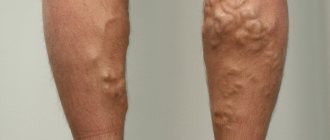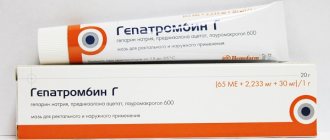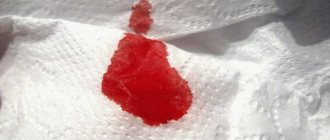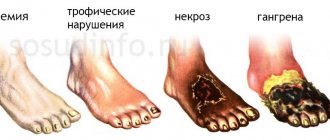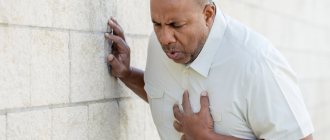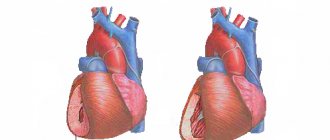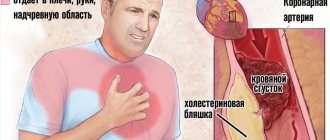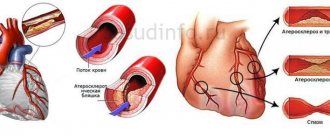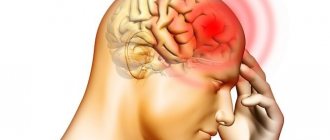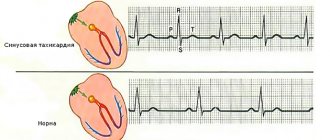Hemorrhoids are an unpleasant disease that causes discomfort and pain in the anus. But many are embarrassed to talk about it and even consult a doctor, so often the first stage of hemorrhoids is not diagnosed and proceeds without proper treatment. However, it is precisely at the beginning of the development of the disease that effective methods can be selected to quickly eliminate the problem without negative consequences for the body. To understand how stage 1 hemorrhoids can be cured, you need to understand the causes of rectal disease, as well as understand what symptoms accompany the emerging problem. It is important to consult a doctor at the first signs of the disease and not delay treatment so that the disease does not become chronic. Otherwise it will be much more difficult to get rid of it.
Description of the disease and its stages
Hemorrhoids are often talked about
so: these are the same varicose veins, only in the rectum. But to be objective, this is not entirely true - everything is a little more complicated. Hemorrhoids are called cavernous formations: there are three of them in the rectum, and there are also three in the anal area (that is, outside). If the blood flow is normal, there are no negative factors, the nodes are insignificant, then the person will not feel their presence at all.
But when blood circulation is disrupted, stagnation occurs in the vessels. The nodes seem to swell from excess blood. And if nothing is done, blood stagnation only increases, which can cause bleeding, inflammation, and even the development of infectious processes.
Hemorrhoids manifest as pain and severe discomfort. But at the first stage, the symptoms are not so obvious, so many patients simply ignore them. And in vain - this is that very favorable period when the patient himself is able to prevent the disease from developing.
Hemorrhoids and their stages (external hemorrhoids):
- Stage 1. It is characterized by the appearance of an external lump;
- Stage 2. Thrombosis in the hemorrhoidal node;
- Stage 3. The appearance of fringes.
The following stages are characteristic of internal hemorrhoids: stage 1 of hemorrhoids may be accompanied by bleeding, at stage 2 pain is added to it, at stage 3 prolapse of hemorrhoids is noted. Stage 4 internal hemorrhoids are fraught with prolapse of the rectal mucosa.
How to treat?
Stage 2 surgery is prescribed only in extreme cases. Treatment usually begins with conservative methods.
For it to be as effective as possible, the doctor’s advice must be strictly followed , and do not stop taking the medications when the symptoms subside.
Treatment of stage 2 hemorrhoids without surgery is long and can take several months.
Usually one cannot do without pills; the following are prescribed:
- Troxevasin, Detralex, which improve vascular tone, eliminate their fragility, and prevent the formation of new nodes.
- To reduce inflammation and relieve pain, the doctor may prescribe painkillers and anti-inflammatory drugs - Diclofenac, Ibuprofen.
Local treatment is used to relieve symptoms, but almost always in combination with tablets.
Effective ointments for stage 2 hemorrhoids:
Anti-hemorrhoids ointment helps relieve inflammation, improve blood circulation and vascular condition, softens, facilitates bowel movements and prevents damage to nodes.
Suppositories for hemorrhoids often contain an anesthetic that relieves pain and itching, makes you feel better, and also helps stop bleeding and prevent infection of the nodes.
Which suppositories are best is determined by a specialist based on the patient’s complaints, examination and assessment of the condition.
- Proctosedin reduces pain and relieves swelling,
- Prednisolone relieves pain and burning,
- Hepatrombin G reduces thrombosis.
- To stop bleeding, suppositories with adrenaline are used.
Novocaine blockade for stage 2 hemorrhoids is rarely performed, only when other means do not relieve pain. This procedure should be performed by an experienced technician.
To improve the general condition and speed up recovery, the proctologist may prescribe mild laxatives and drugs to improve intestinal microflora. They improve the condition of the mucous membrane, facilitate bowel movements, making it less painful.
Treatment at home
To treat stage 2 hemorrhoids at home, traditional methods are used:
- Sitz baths with decoctions and infusions of anti-inflammatory herbs (not hot, the water temperature should not exceed body temperature. Too cold is also not an option, since it can cause inflammation of the cones).
- Microclysters using decoctions and infusions of chamomile and nettle . Oil enemas (olive, vaseline oil) are also used. The volume of the therapeutic enema should not exceed 100 ml. It is placed after cleansing or natural bowel movement. In some cases, an oil enema is used for constipation to ease bowel movements. Do not do this if there is severe bleeding or inflammation.
- Treatment at home for stage 2 hemorrhoids involves both a diet (maximum fiber, fresh vegetables and juices, a minimum of light carbohydrates and baked goods), and the use of herbal decoctions - anti-inflammatory and hemostatic. The same chamomile and nettle will come in handy.
Complete symptoms of stage 1 hemorrhoids
According to statistics, the sensations described below are familiar to about eight out of ten people. That is, almost every person felt something similar, but this does not mean that he further developed hemorrhoidal disease.
Symptoms of grade 1 hemorrhoids:
- Feeling of discomfort in the anal canal, especially after bowel movement;
- Feeling that the intestines are full, even if a bowel movement has just taken place;
- Burning and itching, tingling sensations in the anal area, which only intensify with defecation;
- Drops of blood or even whole smears of blood on stool, toilet paper, underwear.
If you see blood, it means that congestion in the nodes has already thinned the mucous membranes. The walls actually thin out quite quickly and react with bleeding to virtually any irritation. This may be straining during bowel movements, rocky stool, or too active intestinal motility.
What to do if you have anxiety symptoms
There is only one answer: the doctor knows how to treat the first stage of hemorrhoids. You need to make an appointment with a proctologist, undergo an examination, take tests and receive individual prescriptions. Many people, out of shyness, simply do not do this, and thus waste precious time: if you do not come to the doctor on time, subsequent treatment will no longer be so simple, and its effectiveness will also not be one hundred percent.
The first stage of hemorrhoids is treated conservatively: suppositories, ointments, if necessary, tablets (possibly venotonics), important recommendations regarding nutrition and lifestyle. And the development of the disease in this way can really be blocked. If the inflammation is not stopped at an early stage, complications will not keep you waiting.
What happens if you don't treat hemorrhoids:
- Hemorrhoids are full of stagnant blood, and this condition becomes chronic;
- In this form, they can no longer remain in their physiological places - the nodes are displaced and then fall out of the rectum;
- At first, the loss of nodes is provoked by tension and physical effort, then it happens completely arbitrarily;
- For some time, the fallen nodes themselves are drawn back into the anal canal, then they need to be reset manually, but at the last stage of hemorrhoids it is simply impossible to reset them.
The prospect is very gloomy: and this can happen to very young people, full of strength and plans. Go to a proctologist, find out how to treat stage 1 hemorrhoids in your case, and how to further prevent the disease.
Is it possible to cure stage 1 hemorrhoids without medication?
Those who ask such a question want to answer with the same question - why are you so against drugs? It is more important for the body to receive timely, adequate help than to become an object for experiments with various folk recipes (not the most harmless, by the way).
If you are categorically against medications, try to follow all your doctor's recommendations: from proper nutrition to exercises for developing anal muscles. If all this helps and the disease goes away, you can only be congratulated. But such achievements are rare.
Even the initial stage of the disease serves as a basis for drug treatment, and you should not be afraid of this.
How to cure stage 1 hemorrhoids:
- Take venotonics. This is the name of pharmaceuticals that eliminate weakness of vascular tone. They stabilize blood circulation, strengthen vascular walls, and eliminate such dangerous venous congestion. Their action reduces the likelihood of developing rectal bleeding. The most famous and truly outstanding drugs in this group can be considered Detralex and Phlebodia 600.
- If necessary, take pain medication. If the pain is minor, you shouldn’t do this, but if the painful sensations literally unsettle you, take the medicine. Ibuprofen and Diclofenac are good options.
- Use folk recipes as an addition to the main therapy. So, it would be good to do sitz baths with medicinal herbs (calendula, oak bark, chamomile) from time to time. If possible, take such baths for 15 minutes after each bowel movement.
- If you suffer from constipation, regulate your diet, and if necessary, drink a laxative. These are Duphalac, Mucofalk, Bisacodyl syrups, etc.
Plant-based rectal suppositories are very helpful in the treatment of uncomplicated hemorrhoids.
Sea buckthorn candles, as well as candles based on bee products (honey, propolis), give an excellent effect. For more severe symptoms of hemorrhoids, you should buy combined suppositories.
Treatment at home
Local treatment of hemorrhoids includes suppositories, ointments and gels. They are used externally and have anti-inflammatory, regenerative and analgesic properties. At the first stage of this pathology, the following ointments are used:
- levomekol;
- relief;
- posterized;
- methyluracil.
Treatment with ointments is carried out as prescribed by a doctor and according to the instructions. Each drug has a specific effect on the tissue and must be used at a certain stage. Candles have a good effect on internal nodes. Treatment with these drugs is carried out in the morning and evening. The most popular suppositories are:
- procto-glivenol;
- relief Advance;
- sea buckthorn candles.
Alternative treatment will help complement conservative therapy. Baths with chamomile, string and oak bark perfectly relieve pain and relieve inflammation.
How to eat properly if you have hemorrhoids
At the first stage of hemorrhoids, you definitely need to review your menu. Some errors in nutrition can increase the manifestations of the disease and provoke inflammation.
Proctologists have long drawn up rules for a balanced diet for hemorrhoids, and recommend that all patients interested in recovery follow them.
Recommendations from proctologists on proper nutrition:
- Food enriched with fiber is the basis for healthy intestinal function. You definitely need to consume coarse plant fibers, which play the role of “brushes” in the digestive tract, carefully but effectively doing their job. They enhance intestinal motility, making defecation easier. Thanks to such food, the risk of injury to hemorrhoids and associated painful manifestations is reduced.
- Drink a lot. 2 liters of clean water a day is already tired advice, but you can’t escape it. Nothing will cost you as little as it and nothing will give such absolute benefit. If you drink little, your stool becomes denser. It is more difficult for such masses to move along the rectum; a person will have to strain, strain – and this cannot be done with hemorrhoids. In addition, hard feces can damage the node itself or injure the anal valve. In order to soften the feces, maintain an optimal drinking regime. Drink clean, still water, herbal and fruit teas, and drinks with minimal amounts of sugar.
- Eat small meals. This is a feature of the diet for hemorrhoids. Eat in small portions, but 5-7 times a day. Have snacks only at strictly designated times. This will set up your digestive tract to function properly.
Certain foods are useful for hemorrhoids, including cereals, vegetables, fruits, bread, and dried fruits. If there are no restrictions from the gastrointestinal tract, you can also consume fermented milk products - it’s good if it’s kefir with bifidobacteria and lactobacilli. When it comes to meat and fish, try to choose lean varieties. Eat chicken, turkey, rabbit, fish - hake, pike, cod. The preferred oils are flaxseed and olive. You can add them to salads or drink a tablespoon in the morning, immediately upon waking up.
Therapeutic measures
All stages of hemorrhoids are treatable. At the initial stages of the disease, conservative therapy is sufficient, the effectiveness of which decreases significantly as the pathological process progresses. After drug treatment, relapses of the disease often occur, which is due to the chronic nature of hemorrhoids.
Conservative therapy
The main goal of non-surgical treatment is to reduce the likelihood of developing annual exacerbations, their duration and severity. Conservative treatment has the following indications:
- initial stage of development of the chronic form of the disease;
- acute period of illness in the later stages of the disease.
Conservative treatment is necessarily complemented by preventive measures, which include normalization of the functioning of the digestive system, regulation of consistency and transit of intestinal contents through the colon.
Conservative treatment consists of the following manipulations:
- general effect - the prescription of phlebotropic drugs (Detralex, Venoruton), which reduce increased venous tone and improve blood microcirculation in the area of the cavernous bodies, normalizing blood flow;
- local effect - the prescription of combined local anesthetics and non-narcotic analgesics (Gepatrombin G, Aurobin, Prosterizan, Nefluan, Ultraproct). This approach allows you to eliminate pain, inflammation and thrombosis in the area of hemorrhoids;
- stopping bleeding - in acute cases, when bleeding does not stop for more than an hour, suppositories containing adrenaline are prescribed. Local preparations containing thrombin and fibrinogen (Beriplast, Spongostan, Adroxon) are effective.
Minimally invasive therapy
Minimally invasive treatment is an aggressive technique for eliminating hemorrhoids, which is used when conservative therapy is ineffective. Today, there are several comfortable outpatient methods by which you can permanently get rid of prolapsed hemorrhoids. This method of exposure is effective for any stage of hemorrhoids provided there is no thrombosis, inflammatory diseases in the perineum and anal canal, as well as chronic and acute paraproctitis.
The following minimally invasive techniques that do not require anesthesia can be distinguished:
- latex ring alloying;
- sclerosis;
- cryodestruction;
- infrared photocoagulation.
What not to eat if you have hemorrhoids
If you are diagnosed with chronic internal hemorrhoids of the 1st degree, you will have to give up many foods. After all, it is important to know not only what to eat, but also to understand what you should not eat.
The following should be excluded from the menu:
- Pasta – pasta made from soft wheat varieties is especially harmful;
- Fried foods (including fried fish and meat);
- Smoked, salty, pickled foods;
- Seasonings and spices - allowed only in minimal quantities;
- Wheat bread;
- Mushrooms are a difficult product for the gastrointestinal tract;
- Bakery products, confectionery products, chocolate;
- Strong tea and coffee;
- Cabbage (white cabbage), legumes.
Pasta
Smoked meats
Seasonings and spices
Wheat bread
Baking
Mushrooms
Coffee
Cabbage
You also need to reduce the consumption of rice and semolina porridge, as these cereals complicate the work of the intestines. Remember that food should be baked, stewed, boiled, steamed, but not fried.
Physical activity for stage 1 hemorrhoids
It is also very important how correctly your physical activity is organized. Even a simple morning exercise that does not require special effort and time will relieve you of unwanted congestion in the pelvic area, as well as subsequent difficulties with bowel movements. Of course, it is advisable to discuss all exercises for hemorrhoids with a proctologist - he will tell you what you need to do specifically for you. This should be done especially for women and people with serious chronic diseases: in this case, many exercises will be excluded.
With stage 1 hemorrhoids, you can walk a lot, jog, and swim. But if an exacerbation occurs, then only quiet walking walks that do not cause discomfort are included in the recommendations.
Exercises have a positive effect not only on the abdominal organs, but also have a direct effect on the functioning of the circulatory system. This improves the health of the body as a whole, beneficial to all patients.
Prevention of hemorrhoids
And so that you don’t need treatment, start preventing the disease right now. It consists of fairly simple things that everyone can stick to.
10 principles for preventing hemorrhoids:
- If you have a sedentary job, do so-called industrial gymnastics every hour. The simplest, most convenient exercises for you that will prevent congestion in the pelvis.
- Eat so that there are no problems with the gastrointestinal tract. Above is detailed information on what to eat and what to avoid. There will be no constipation, the risk of hemorrhoids will be very low.
- Take care of your personal hygiene, wash yourself properly, use soft toilet paper, etc.
- Do not wear too tight, tight underwear or trousers. Nothing should rub the anus area.
- Treat all diseases of the pelvic organs in a timely manner - from candidiasis to cystitis.
- If you ride a bicycle, then choose a model with an anatomically correct seat.
- From time to time, for preventive purposes, take sitz baths with medicinal herbs or a solution of potassium permanganate. In particular, they are useful after constipation or bowel rhythm disorders.
- If your family members suffer from hemorrhoids, without waiting for the onset of the disease, go for a consultation with a proctologist. She will give you all the information on how to make sure that you do not become a victim of negative heredity.
- It is very important for women to eat right and be physically active during pregnancy - this is the time when the expectant mother may encounter hemorrhoids for the first time in her life. During childbirth you need to push as the obstetrician says, incorrect pushing is the cause of painful postpartum hemorrhoids.
- If you notice blood on the toilet paper, if you feel discomfort in the anus, soreness, do not delay visiting the doctor. At the beginning of the disease, treatment will be conservative, as comfortable as possible for the patient. If you neglect the disease, you may end up on the operating table.
There is nothing shameful about hemorrhoids; most of your friends suffer from this disease - just imagine how many people need help. And embarrassment and infantile fear prevent them from responding in time to the first alarm bells. If you have been diagnosed with the first stage of hemorrhoids, you have the power to contain the progression of the disease. Even if everything went rather quickly, visit the proctologist as planned. It is better to keep the disease under control and go to the doctor for confirmation that everything is fine, rather than live in hidden fear.
Main symptoms
The first stage of hemorrhoids is manifested by mild symptoms. The first thing you should pay attention to is pain during defecation, discomfort also appears, a feeling of incomplete bowel movement is created, this is due to the characteristic dilation of blood vessels with hemorrhoids. Typical signs of hemorrhoids include:
Itching in the anus is a characteristic symptom of the disease.
- Bleeding. Despite the fact that the internal nodes are covered with dermis and are quite difficult to injure, cracks occur during defecation, accompanied by bleeding. There are few of them, inclusions in the stool are noticeable.
- Severe itching and burning in the anus. This is due to the irritating secretions produced by internal hemorrhoids.
- Bloating, feeling of a foreign object in the anus.
Varieties
There are several types of hemorrhoids of the first degree:
- External hemorrhoids appear less frequently at the initial stage of the disease, with nodular formations being localized near the anus. They appear to be small formations that cause discomfort when sitting and defecating. If the disease is ignored, the node will rapidly increase in size, accompanied by unbearable pain at the slightest contact, and the color of the formation will become bluish.
- Internal hemorrhoids are detected during a detailed examination; a colonoscopy will be prescribed, which will allow us to examine the patient’s mucous membrane and exclude the presence of wounds and foreign growths.
- Combined - the presence of hemorrhoids outside and inside. At the first stage of the disease it is extremely rare.
